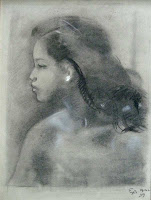Until the 20s the traditional Balinese art was used as decoration of temples, palaces and other official buildings. The development of the Balinese Modernists is mainly due to two European artists: the German painter Walter Spies (1898-1940), who in 1927 arrived in Bali and the Dutch artist Rudolf Bonnet (1895-1978). Walter Spies and Rudolf Bonnet founded in 1936, together with Cokorde Gde Agung Sukawati and the legendary Balinese artist and architect I Gusti Nyoman Lempad the association Pita Maha (Great Life). The purpose of this association was to guarantee the quality of the paintings and sculptures in Bali by the upcoming tourism. The graceful and stylized design, typical of the Art Deco, is incorporated in Balinese subjects, making a special interweaving of form and content.
The first artist was the Dutchman W.O.J. Nieuwenkamp (1874-1950) who in 1904 arrived in Bali and made a huge amount of drawings, etchings and paintings of life on the island. He also collected many Balinese artifacts. In the temple Meduwe Pura Karang is a relief showing a cyclist decorated with floral motifs and an Indonesian sarong-style headdress, W.O.J. Nieuwenkamp, whose long nose - for Southeast Asians a typical feature of all foreigners - clearly preserved. Nieuwenkamp in 1904 attracted the local people by riding bike all over the island. In Edam, Holland, is a museum where his work can be admired.
Rudolf Bonnet (1895-1978) was born in Amsterdam. Bonnet studied on the Hendrick de Keyser School. In 1913 he exam for the National School of Applied Arts. In 1916 he graduated there with good results. He also visited the State Academy of Fine Arts. Around 1920 many artists went to Bali to paint. Other painters encouraged him to go there to and in 1928 Bonnet went, with his parents, to Batavia. He spent some time in Semarang in 1929 and moved to Bali, where he took up residence and started making drawings and paintings. He became very involved in the social life and he worked there for years and even had influence on the Balinese Art.
Wim Hofker (1902-1981) the famous Dutch artist lived and worked in Bali, with his wife for many years. In 1936 he left with her, artist Maria Hofker-Rueter, to the Dutch East Indies, where he landed in Bali and where a large part of his work has been established. During the Japanese occupation of Bali the couple was in a Japanese camp for a couple of years. After the Japanese defeat in 1946 they went back to the Netherlands and settled in Amsterdam.
The German painter, choreographer, writer, photographer and patron Walter Spies (1898-1940), was about 25 years old when he arrived in Indonesia in 1923, and 29 years old when he came to Bali in 1927. Spies give the young, talented artists better materials and alternative subjects for their paintings. In 1935 Vicki Baum spent several months at Walter Spies house in Bali. Based on her experiences there she wrote her famous novel Liebe und Tod auf Bali. In it she describes in terms of a simple Balinese farmer the events leading up to the conquest of South Bali by the Dutch and the Puputan of the Court of Badung. The book testifies to an astonishing empathy in Balinese culture.
Auke Sonnega (Leeuwarden, 1910 - 1963) was a Dutch artist, best known for his paintings he made on the islands of Bali and Java, has created a large part of his short life he spent in Indonesia. In 1957, he again returned to the Netherlands. After his death in 1963 he fell into oblivion. The Frisian Museum wanted to do justice to Sonnega and exhibited more than 60 drawings and paintings. Auke Sonnega, who was trained to carpet and textile designer, went in 1935 to Indonesia. Sonnega was first worked as a designer in Batavia. Later he traveled around in Java and Bali and made stories for local newspapers. After his arrival in Bali were the dancers and making portraits of young men and women his main occupation. Walter Spies and Rudolf Bonnet had great influence on the work of Auke Sonnega.
The Belgian artist Le Mayeur has also worked for many years in Bali and has a large oeuvre. Museum Le Mayeur Bali is located in the former home of the Belgian painter Adrien Jean Le Mayeur the Merpres (1880-1958) and his Balinese wife Ni Pollok. In 1932, Le Mayeur met his wife Ni Pollok. She was a famous dancer and was known as the best dancer of Bali. She often posed for him and eventually the two married. In the museum are paintings with Ni Pollok, but also many other Balinese women working with him. After his death he left the house and his work to Ni Pollok. When Ni Pollok died in 1985, the house become Museum Le Mayeur.
The Italian artist Emilio Ambron (1905-1996) has been working in Bali in 1938. He lived next to Wim Hofker and his wife Maria. There were difficulties when Ambron started using a model that already was working for Hofker. Eventually the two painters decided that the model would pose for them both. Ambron came back again in Bali in 1968, 1974 and 1994. In Bali is a small museum in the city of Klungkung in honor of this artist.
The famous Dutch painter Isaac Israëls (1865-1934) has also worked on Bali. In 1921/1922 he made a trip to India and visited also Solo, Batavia and Bali. In Bali he painted female figures. Israëls has also worked as a portrait painter at the court of the Mangkoenegara and the Craton of Sunan.
Other painters of later date where Han Snel, Arie Smit and Antonio Blanco, they almost all took the Indonesian nationality.
Langganan:
Posting Komentar (Atom)









0 Response to "Painters in Bali"
Posting Komentar